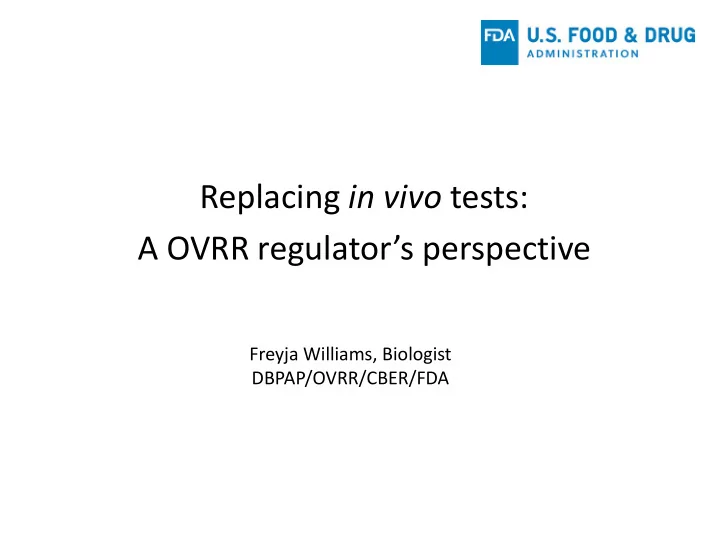

Replacing in vivo tests: A OVRR regulator’s perspective Freyja Williams, Biologist DBPAP/OVRR/CBER/FDA
My comments are an informal communication and represent my own best judgment. These comments do not bind or obligate FDA. 2 www.fda.gov
Focus • Product testing requirements and recommendations in general • Replacement of approved product tests 3
Product quality control • Process control – Process validation – Manufacturing consistency • Batch production records • Intermediate, drug substance and drug product testing – Assay selection: able to detect relevant changes in critical quality attributes – Assay validation: method adequately precise and accurate for its intended purpose 4
Release testing for licensed products • Relevant regulations – 21 CFR 211.160: General requirements – 21 CFR 211.165: Testing and release for distribution • Guidance documents – Analytical Procedures and Methods Validation for Drugs and Biologics, CDER/CBER July 2015 5
Analytical Procedures and Methods Validation for Drugs and Biologics CDER/CBER July 2015 • Each BLA must include a full description of the manufacturing process, including analytical procedures that demonstrate the manufactured product meets prescribed standards of identity, quality, safety, purity, and potency. • Analytical procedures must “meet proper standards of accuracy, sensitivity, specificity, and reproducibility and are suitable for their intended purpose. • When an analytical procedure is approved/licensed as part of the NDA, ANDA, or BLA, it becomes the FDA- approved analytical procedure for the approved product. 6
Method replacement CDER/CBER 2015 Over the life cycle of a product, new information and risk assessments (e.g., a better understanding of product CQAs or awareness of a new impurity) may warrant the development and validation of a new or alternative analytical method. • The new method coupled with any additional control measures is equivalent or superior to the original method for the intended purpose. • The new analytical procedure is not more susceptible to matrix effects than the original procedure. 7
Typical in vivo tests for vaccines • Potency – Immunize animals – Measure immune response or challenge animals – Calculate relative or absolute potency • Safety – Dose animals – Measure adverse outcome – Compare outcomes to reference or established limit 8
in vivo Potency tests Advantages • Final drug product test • Adjuvanticity (if relevant) • Interaction among product components • Complexity of epitopes – Does not need complete understanding of protective mechanism or epitopes • Holistic measurement of immune response • Demonstrated to be able to detect changes to product during licensure 9
in vivo potency tests Disadvantages • Relevance of animal to human protective responses • Variability • Expense • Time • Nonconformance with the 3Rs 10
Ideal in vitro potency test • Test all active components of the final product • Biologically relevant – Measures critical quality attributes that contribute to potency – Sensitive and specific • Precise and accurate • Sustainable 11
in vivo Safety • Advantages – Holistic approach – Interaction among components – Measures multidimensional biology of adverse effects • Disadvantages – Relevance of animal responses to human experience – Variability – Expense – Time – Nonconformance with the 3Rs 12
Concerns when replacing approved tests • Maintenance of consistent product quality – Unlikely to generate additional clinical data to support change in testing Ability to detect relevant changes in product quality • – Assess changes in potency • Antigen content (concentration) • Antigen structure (forced degradation) – Assess changes in safety • Impurities and contaminants in the matrix, or inherent reactogenic components – Assess changes over time when used in stability testing • Ability to set appropriate product acceptance limits based on comparability of the two methods – Proposed test should not accept lots that would be rejected by the approved test – Proposed test has equivalent or better sensitivity 13
Comparison issues • Comparisons of test results for lots within the normal manufacturing range may be uninformative – Not enough product variability to distinguish the product from the assay variability – Overcome using mock samples with known levels of analyte that would be out of specification • Identification of the analytes relevant to critical quality attributes – All immunogenic epitopes may not be relevant to efficacy – Endotoxin is not the only pyrogen 14
Friendly advice • Changes to product potency and safety tests for FDA licensed vaccines require approval before implementation • Approaches to demonstrate comparability may be product and test specific • Talk to us early, talk to us often • Use the existing guidances as resources 15
Recommend
More recommend